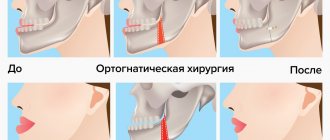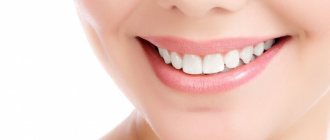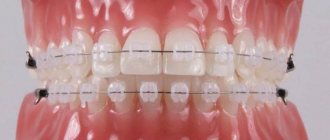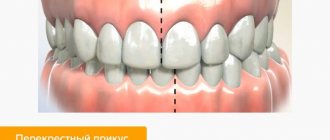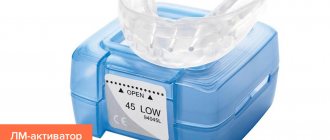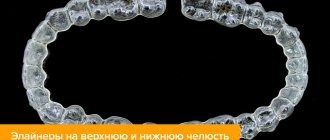Bite correction is a well-known and very painful topic for both adults and children. Most of us associate this procedure with creepy mechanisms and ugly plates that make children suffer from ridicule from their peers and cause inconvenience to adults.
Fortunately, this was the case before - now correcting a bite means:
- not painful;
- fast enough;
- can be simple and unnoticeable.
How? The doctors of the President clinic know all this - and they will be happy to share their knowledge with you: they will tell you how the bite is corrected, what is used for this and how long the whole procedure takes. The most important thing is that you don’t need to go to the clinic to get this information—you can find out the information listed in a few seconds. Shall we begin?
Why is it necessary to correct the bite?
Do you think it's worth correcting an overbite? Of course, it’s worth it, since this violation can cause both aesthetic discomfort and illness. Speaking in more detail, an incorrect bite leads to serious consequences.
- May cause premature tooth loss. Due to the curvature of tissues, teeth not only grow incorrectly, but also fall out more often.
- May cause psychological problems. Unattractive teeth do not contribute to bright, open smiles or joyful laughter. Think about it - are you often embarrassed to laugh openly?
- It can cause the development of diseases, such as periodontal disease.
Important: That is, malocclusion is not just an aesthetic, but also a medical problem. Fortunately, the solution is very simple - correcting the bite occurs quickly and painlessly.
Complications
The duration and nature of complications are individual in nature and resolve spontaneously after some time:
- pain syndrome. Occurs against the background of traumatic effects on tissue/bone tissue;
- inflammation of soft tissues. Develops due to displacement and overload of bone fragments;
- divergence of seams. Requires reapplication;
- general weakness, nausea. Occurs after anesthesia;
- hyperemia/swelling. Observed immediately after the intervention, after 3-4 days the facial contours return to normal;
- constant numbness in the facial area due to nerve damage;
- speech disorders. If the dysfunction is severe, professional help may be required.
The recovery period lasts 10-14 days. It is recommended to adhere to a soft diet for the first 7-8 days: consume dairy products (yogurt, kefir, cottage cheese), eggs, boiled potatoes. In the next 14 days, it is allowed to supplement the diet with boiled meat and pasta.
After the swelling disappears, it is necessary to begin physiotherapeutic training: closing/opening the mouth, performing lateral movements.
How is a malocclusion corrected?
Correcting malocclusion is quite simple - with the help of modern braces. These bracket systems can be:
- metal;
- ceramic;
- sapphire;
- self-regulating;
- lingual.
The main feature that unites all of the listed types of braces is that they are manufactured and customized individually. That is, the entire adjustment procedure will take place individually, and braces will not interfere, either in everyday life or in personal life.
Self-ligating braces are considered the most effective. They not only help correct your bite, but also do it quickly and as comfortably as possible. Such systems help correct malocclusion even in adults.
But, regardless of the type of braces chosen, correcting a bite usually consists of several stages.
- First, the patient comes to the dental clinic, where the orthodontist conducts an examination and provides recommendations on correcting the bite and choosing braces.
- Afterwards, the selected bracket system is installed. Its installation is painless and fairly quick.
- After installing the braces system, the patient will need to visit the orthodontist to monitor the process and adjust (tightening the braces). By the way, when choosing self-ligating braces, the number of visits will be reduced to a minimum, since only this brace system requires minimal supervision from a doctor.
- After a certain time (usually correcting a bite takes at least a year and a half), the doctor removes the braces - and you can enjoy a full life and perfect teeth.
There is nothing scary about the procedure for correcting a bite - it is painless and quite quick. At the same time, while wearing braces, you can not only correct your bite, but also look attractive - especially if you choose lingual, sapphire or ceramic braces. All of these braces are virtually invisible to others, which means you can combine your daily life with your dental procedure.
Do you think that bite correction is only available to children and teenagers? This is not entirely true - and in order for you to be convinced of the insignificance of this opinion, we suggest that you continue reading the article and find out at what age your bite can be corrected.
When can a malocclusion be corrected?
Malocclusion can be corrected at any age. This has been confirmed by numerous studies and the experience of our patients.
For each age, it is recommended to use certain braces. They regulate both the time of the procedure and its effectiveness. For example, for children under 16 years of age, you can choose any braces - from metal to lingual. At a more mature age, it is worth paying attention to self-regulating braces - their functional features allow you to obtain optimal results in a relatively short time.
Important: Bite restoration is not the most terrible procedure. Therefore, you should not wait until health problems or complexes take over - just contact one of our clinics and be beautiful.
Indications
- open lateral bite. It is characterized by the presence of a gap between the jaws: the face becomes asymmetrical, the functioning of the facial muscles is disrupted, and the risk of damage to the mandibular joint increases. The patient is unable to chew food or swallow/breathe normally;
- incorrect frontal closure. Provokes disruption of the chewing process, distorts diction;
- chin dysplasia. With this pathology, the configuration and shape of the chin are greatly changed, as a result of which the appearance deteriorates and problems arise with closing the lips and diction.
Contraindications
: age under 18 years, diabetes 2-3 degrees, diseases of the blood, heart muscle, blood vessels, individual intolerance to anesthesia, oncology.
What is malocclusion?
In dentistry, a pathology such as malocclusion is the presence of contact between the upper and lower dentition in the position of central occlusion. The manifestation of malocclusion can be either too noticeable or completely insignificant, and in special cases, the chewing function of the jaw is disrupted and visible changes begin to occur.
When visiting a clinic as an adult, surgical intervention is not only not recommended, but it will not bring an optimal result. Most often, the detection of malocclusion occurs in the presence of a slight disturbance in the closure of the dentition, which allows the defect to be eliminated without taking serious measures.
Important: Experts recommend contacting dentists as early as possible in order to avoid serious consequences in the form of distortion of facial features and high financial costs.
Factors contributing to the occurrence of pathology
There can be an incredible number of reasons why such a defect as malocclusion can occur, but there is the most basic one - heredity. In other words, if at least one of the relatives has such a defect, the probability of its manifestation in the child is 50%
An incorrect bite can occur when the facial bones are injured and even when teeth are knocked out. In this case it is noted:
- tooth displacement;
- increasing the space between teeth;
- the appearance of a change in the nature of the closure of the upper and lower dentition.
There is one more reason that cannot be ignored, and this is the partial or complete absence of breastfeeding in newborn age. For this reason, pathologies can occur extremely rarely, but this is quite possible. Experts believe that the process of sucking breast milk allows you to complete the development of the jaw and thereby eliminate not only the defect in the form of malocclusion, but also such consequences as burr and unclear diction.
What types of braces exist and their features?
Braces are small plates that are installed on the teeth using a special adhesive composition and connected to each other with a metal arch. The connecting wire has a kind of shape memory, due to which it has a uniform effect on the entire dental composition, which gradually aligns them.
As already mentioned, the type of braces can be:
- metal;
- ceramic;
- sapphire;
- lingual;
- unligated.
Each type has its own technical characteristics and main advantages, due to which they are chosen.
Metal braces are recognized as the most affordable, however, metal braces have one single drawback - their appearance, which can hardly be called aesthetic and attractive, but it is due to it that minimal friction is ensured between such elements as the arch and groove, which allows for minimal time frame for correcting the defect.
The choice of ceramic braces is based solely on aesthetics. Their cost is much higher than metal ones, but the peculiarity is that they are almost completely invisible on the teeth. In other words, such braces can take on the color of the enamel, and they also do not give off glare from exposure to light.
Pros of ceramic braces:
- miniature size;
- with maximum strength;
- made of finely dispersed ceramics.
Such braces are resistant to dyes, and therefore you can significantly increase your diet without fear that the structure will become stained and lose its proper appearance. The advantage of ceramic systems is wear resistance and strength, which allows you to easily remove braces after treatment, without additional cutting from the tooth, since some products of other types can be destroyed
The peculiarity of sapphire braces is their transparency, strength and resistance to dyes, however, they are best used for those who have white teeth, so that the overlays do not differ from the composition of the teeth and do not attract attention. They glare brightly when exposed to light, especially neon. Due to too much friction between the arch and the groove, tooth alignment occurs more slowly than with metal onlays. Their cost is higher than that of ceramic braces.
For those who do not want to wear braces, but require alignment, the lingual type is perfect. The advantage is complete invisibility, since the installation is carried out on the teeth from the inside. For manufacturing, gold-containing or any other alloy is used. It is advisable to choose the first option, as it will not oxidize and leave an unpleasant taste on the tongue. The downside is that to install such a system you need a qualified specialist who can carry out the work with the highest quality and without a single defect. In the first days after the installation of braces, a change in diction may be noted, as the tongue needs to adapt to the new devices in the mouth. In addition, they are very difficult to care for.
Non-ligation type braces differ from classic ones in that they are installed using special clips, due to which the arch is fixed. There are no ligatures, and therefore it is easier to care for them, but the braces themselves are too noticeable and very large. In terms of effectiveness, they can be compared with ligature ones.
How to straighten teeth without braces?
The development of modern technologies does not stand still, and therefore it is possible to choose a lot of options to straighten the teeth without surgical intervention and braces. As a rule, devices such as:
- veneers;
- aligners or aligners;
- vestibular plates;
- trainers.
Just like braces, they have their own differences in design and method of application.
- Veneers are a special covering on teeth, consisting of plates whose thickness is 0.5-0.7 mm, and their main task is to improve the aesthetic appeal of the teeth. For example, if there are defects on the teeth such as chips, unevenness or different lengths, as well as gaps between the teeth, then veneers can hide all this. To be more precise, veneers do not even out the teeth, but mask defects. They are made individually for each person by taking impressions. There is an alternative option for veneers - luminars, which can give exactly the same effect, but they do not contribute to wearing down the enamel, which allows them to be removed if necessary. The thickness of luminars is much smaller, which is why they are not used to correct serious smile defects.
- An aligner or mouth guard is made from transparent polymers and resembles a removable cap in appearance. To create such attachments, a photograph of the face is required, as well as taking an impression of the jaw, and after this, a 3D model is created in special factory conditions and the caps are formed from it. Treatment requires an average of 12 months, and the caps are removed after eating or when brushing the teeth. Experts consider aligners to be a stripped-down alternative to braces, which should be used for minor dental defects. Treatment with aligners does not require the participation of a specialist in the process, since the caps are sent from the laboratory for the entire course of eliminating defects. That is why the responsibility lies solely with the patient himself, and if one of the caps is not worn, the defect may worsen or a new one may arise. Accordingly, all therapy should be started from the very beginning.
- The use of vestibular plates is carried out from the age of 2-5 years. They are installed in order to wean children from bad habits, for example, finger or nipple sucking, which can cause malocclusion. In other words, it is not the elimination of the bite defect that occurs, but the removal of the cause of its formation. In some cases, it is enough to use the plates for just a few weeks, but in general the duration depends only on the physiology of the child. Such plates are made only from hypoallergenic and baby-safe material. If you have problems with diction or pronunciation of specific sounds, then you should use plates with an addition such as a bead or a shutter.
- Trainers are a silicone splint that has properties such as softness, elasticity and ease of molding into the shape of the jaw. To ensure the correct positioning of the teeth, it is necessary to install trainers on the cavity of the upper and lower jaw. With the help of such a device, too much muscle pressure is relieved, and the tongue is brought into an optimal position, which forms correct nasal breathing and can eliminate snoring. The main advantage is that they are worn both day and night, but they can only be used at night, and used during the day for only a couple of hours. This method does not cause discomfort and is considered the most painless, and also does not require too complicated care, since it is enough to simply remove them and put them in a container. For cleaning, use a regular toothbrush. Unfortunately, the design has a drawback, but it is not very significant and is that when using trainers you are strictly forbidden to talk, and therefore they are preferably used at night. They are not used to eliminate serious malocclusion.
Treatment with transparent aligners
The undoubted advantage of aligners is that you can evaluate the effectiveness of treatment even before it begins. A special computer program calculates the exact timing of using the trays and allows you to visualize the results of treatment. A set of mouth guards is manufactured immediately for the entire period of orthodontic treatment. The patient independently replaces the mouthguard with a new one every two weeks. The mouthguards can be removed when eating, brushing teeth, and in vital situations. They must be worn at least 22 hours a day. The system does not in any way complicate the process of brushing teeth and does not affect the quality of oral hygiene. The risk of developing caries during orthodontic treatment with clear aligners is minimal. Also, you do not have to buy special brushes and special devices for cleaning your teeth.
Exercises to correct your bite
According to statistics, malocclusion occurs in almost every 4 people on the planet, but only a third of them prefer to eliminate the problem by contacting doctors, and the rest simply leave the defect as it is.
Important : Unfortunately, the lack of intervention can cause more serious consequences, for example, as already mentioned, distortion in the aesthetics of the face, which occurs due to deformation of the teeth.
Treatment of such a defect is not simple and requires an investment of not only money, but also effort, time and, most importantly, a lot of patience. In some cases, it may take up to several years for the bite to return to normal. To achieve a positive result, you need to carry out complex treatment, which includes:
- a special orthodontic design is used;
- constant visits to the doctor are required;
- you must follow all the doctor’s recommendations;
- You also need to pay independent attention to special exercises that can significantly increase the process of straightening your bite.
If for other reasons a visit to the dental clinic is required, then in the case of exercises, correcting the curvature of the teeth at home is much easier to carry out and does not require too much time or special equipment. The process involves training the facial muscle, which can simplify the problem and perhaps you won’t need to wear braces for a long time.
Important: It is especially important to conduct training for teenagers and young children, since at a young age it is much easier to eliminate all kinds of speech defects, including such pathology as malocclusion. The effectiveness of the gymnastics presented below has been tested by time, and it is recognized as the best among all available.
- The mouth is opened and the jaw is closed rhythmically.
- You need to reach the surface of the palate with the tip of your tongue and try to move your tongue back.
- Once the tongue reaches its maximum point of deflection, the jaw must be opened and closed several times.
- Next, your elbows are placed on the table and your chin rests on your open palms. In this position, the oral cavity opens and closes.
Each subsequent step should be done at least 5 times, and ideally as many times as possible. You also need to literally force your jaw to work, for example, chew apples, carrots and similar foods, but of a hard type. Thus, it is possible to prevent the occurrence of malocclusion or eliminate it at the initial stage. Quite often, this is the technique used by speech therapists in medical and preschool institutions.
The most important thing is not to give up and strive to achieve your goal. Only in this case can you avoid consequences and maintain the aesthetics of your smile with clarity of diction.
Patient Reminder
- Patients who have suffered an acute viral infection 10-14 days before the procedure are not allowed to undergo surgery. Any ailment (high blood pressure, temperature, gastrointestinal disorders, sore throat) requires rescheduling surgery;
- on the eve of hospitalization (10-12 hours) it is recommended to refrain from drinking alcoholic beverages and smoking;
- before surgery, taking liquids/food is strictly prohibited;
- You should wash off your makeup, remove dentures, jewelry, and contact lenses;
- The doctor must be aware of existing allergies to medications and routine medications taken.
The duration of the procedure depends on the volume and complexity: correction of defects on both jaws takes 4-4.5 hours, on one jaw - 1-1.5 hours, correction of the chin - 6-6.5 hours. Jaw fusion occurs in 2-4 months, wound healing in 10-14 days.
